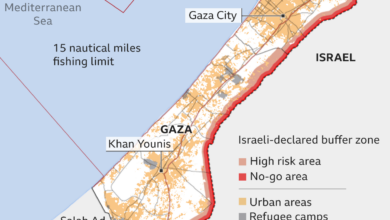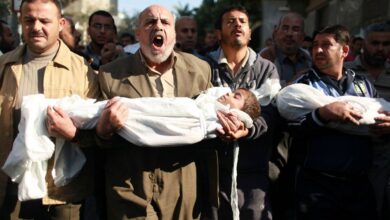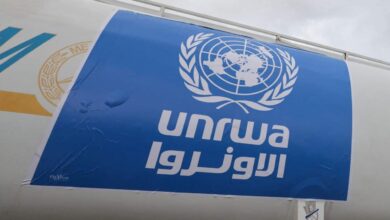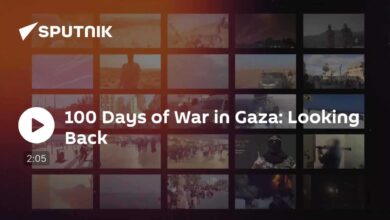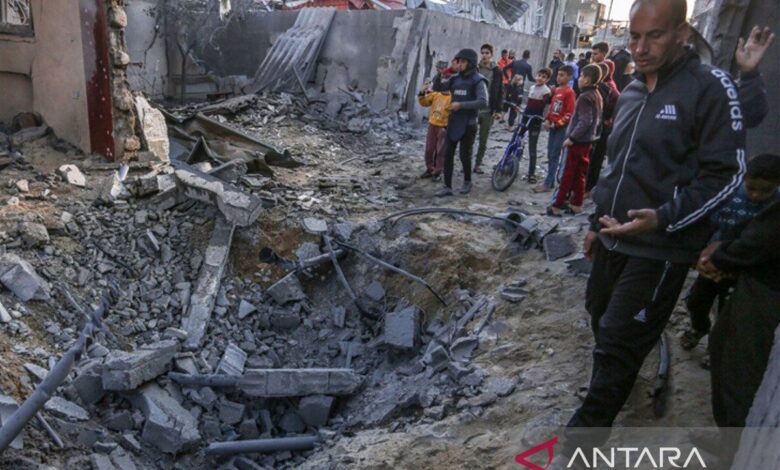
Rafah Israel Gaza War A Deep Dive
Rafah Israel Gaza War: A devastating conflict gripping the region, this war has deeply impacted the Rafah border crossing, leaving a trail of humanitarian crises and political tensions. The fighting has brought immense suffering to civilians, disrupting lives and causing widespread displacement. This post will delve into the historical context, the humanitarian crisis, and the complex political and military dynamics at play.
The significance of the Rafah border crossing is undeniable. It serves as a crucial lifeline for Gaza, and its closure during the war has exacerbated the already dire humanitarian situation. The conflict’s impact extends far beyond the immediate battlefield, affecting every aspect of life for those caught in the crossfire.
Historical Context
The Israeli-Palestinian conflict, deeply rooted in historical and religious claims, has resulted in devastating cycles of violence and displacement, particularly affecting the Gaza Strip. Understanding this protracted conflict requires a grasp of the intricate history of the region, the key events that have shaped its political landscape, and the enduring factors that contribute to its persistence. This exploration will trace the evolution of the relationship, highlighting significant events that have impacted the Gaza Strip.The conflict’s roots extend to the early 20th century, with competing claims to the land by Jewish Zionists and Palestinian Arabs.
The British Mandate for Palestine further complicated the situation, setting the stage for the eventual creation of Israel in 1948. This event, and the subsequent displacement of Palestinian populations, is a cornerstone of the ongoing conflict.
The 1948 Arab-Israeli War
The establishment of Israel in 1948 led to a war between Israel and several Arab nations, including those bordering the nascent state. This conflict resulted in a significant displacement of Palestinian populations and the establishment of refugee camps. The 1948 war profoundly shaped the demographics and political landscape of the region, with lasting consequences for the future. The war’s outcome led to the division of Palestine, with Israel controlling the majority of the land, and the West Bank and Gaza Strip coming under Jordanian and Egyptian control respectively.
This division has been a central point of contention in the decades since.
The Six-Day War and the 1973 War
The Six-Day War of 1967 saw Israel capture the West Bank, East Jerusalem, and the Gaza Strip from Jordanian and Egyptian control. This event drastically altered the geopolitical situation in the region and further solidified the occupation of the Gaza Strip. The 1973 war, while not directly related to the Gaza Strip’s occupation, underscored the volatile nature of the region’s political climate.
The ongoing Rafah Israel-Gaza war highlights escalating regional tensions. Global powers are watching closely, with the potential for conflict to spill over into other areas. This situation reminds us of the complex interplay of geopolitical factors, including the strategic importance of the region and the potential for nuclear conflict. Examining the relationship between the US and Russia, and their involvement in nuclear space programs and Pakistan and Asia, provides crucial context.
us russia nuclear space pakistan asia The potential for wider conflict is a significant concern, making the Rafah Israel-Gaza war more than just a local conflict. This is a critical moment for global diplomacy.
The Oslo Accords and Subsequent Agreements
The Oslo Accords of the 1990s represented a significant attempt at peace. These agreements aimed to establish a Palestinian state alongside Israel, but ultimately failed to achieve lasting peace. Further agreements, such as the Camp David Accords and others, attempted to address the core issues, but the lack of progress on critical matters, such as borders and settlements, undermined their success.
The Oslo Accords and subsequent negotiations demonstrate the complexities of reaching a comprehensive resolution to the conflict.
Key Contributing Factors to the Ongoing Conflict
The ongoing conflict in the region is fueled by a complex interplay of factors. These include competing territorial claims, differing interpretations of historical events, economic disparities, the role of international actors, and the impact of settlements on the region’s demographics. These factors demonstrate the difficulty of achieving a lasting resolution.
The ongoing Rafah Israel-Gaza war is incredibly complex, and the humanitarian crisis is truly heartbreaking. Meanwhile, sports news is also making headlines, like the recent contract negotiations for Chiefs star Andy Reid. Andy Reid Chiefs contract negotiations are a fascinating distraction from the tragic events in Rafah, but ultimately, the war’s impact on the region and its people remains the critical issue.
- Territorial Disputes: The core of the conflict often revolves around differing claims to the same land. Different interpretations of historical rights and ownership have made resolution of land boundaries extremely challenging.
- Security Concerns: Both sides often cite security concerns as justification for their actions. These concerns, often perceived differently by each side, have hindered efforts towards peaceful coexistence. For example, the need for security in Israel often clashes with Palestinian desires for freedom of movement.
- Role of Settlements: The establishment of Israeli settlements in the West Bank and East Jerusalem, in particular, has been a major source of contention, as they are perceived by Palestinians as a violation of their rights and an obstacle to a two-state solution.
Evolution of the Israeli-Palestinian Relationship and its Impact on the Gaza Strip
The evolving relationship between Israelis and Palestinians has had a profound impact on the Gaza Strip. The establishment of Israel, the subsequent wars, and the ongoing political tension have shaped the Gaza Strip’s political and economic development. This complex relationship has been a major factor in the ongoing instability of the region.
Examples of Past Conflicts or Significant Events, Rafah israel gaza war
- The First Intifada (1987-1993): This uprising, sparked by Israeli policies, highlighted the deep-seated frustration and anger felt by Palestinians, particularly in the Gaza Strip. It underscored the need for addressing the underlying grievances and creating a more peaceful environment.
- The Second Intifada (2000-2005): This further escalation of violence further illustrated the challenges of finding a peaceful resolution to the conflict, further impacting the lives of civilians in Gaza. The ongoing violence and instability significantly hampered economic growth and stability.
The Rafah Crisis
The Rafah border crossing, a vital lifeline for Palestinians in Gaza, has been a focal point of humanitarian concern during the recent conflict. Its closure has exacerbated existing hardships and created a new wave of suffering for the already vulnerable population. The crossing’s strategic importance as a primary entry and exit point is undeniable, and its disruption has significant implications for the region’s stability and well-being.The closure of the Rafah border crossing has had a devastating impact on the lives of Gazans.
The crossing’s strategic importance is undeniable; it’s a crucial conduit for essential supplies, humanitarian aid, and medical evacuations. Its closure has resulted in a severe shortage of essential goods and services, severely impacting the civilian population. The lack of access to medical care and adequate supplies is particularly alarming, and has caused further hardship to an already vulnerable population.
The ongoing Rafah Israel-Gaza war is a deeply concerning situation, with devastating consequences for civilians. Meanwhile, the NHL’s St. Louis Blues are reportedly showing interest in trading for Pavel Buchnevich, which is definitely creating some buzz amongst hockey fans. This potential move, like the Rafah Israel-Gaza conflict, highlights the complexities of international relations and the impact of these events on people’s lives.
Will the Blues’ interest in Buchnevich have any impact on the current geopolitical landscape? blues pavel buchnevich trade interest It certainly seems like the world has a lot of issues to grapple with at the moment.
Significance of the Rafah Border Crossing
The Rafah border crossing serves as the primary point of entry and exit for the Gaza Strip. It is crucial for the movement of people and goods, including humanitarian aid, medical supplies, and commercial products. Its closure significantly restricts the flow of essential supplies into Gaza and the flow of Gazans seeking medical care or other opportunities.
Impact of the War on the Rafah Border Crossing
The recent conflict significantly disrupted the operation of the Rafah border crossing. This disruption has resulted in the halting of commercial traffic, humanitarian aid, and the evacuation of critically ill patients. The closure exacerbated existing shortages and created a critical humanitarian situation.
Challenges and Obstacles Faced by Civilians Trying to Cross the Border
Civilians attempting to cross the border face numerous challenges, including strict security measures, bureaucratic hurdles, and lengthy waiting periods. These factors make it incredibly difficult for people to access essential services, reunite with family members, or seek medical treatment outside of Gaza. Limited resources and a lack of coordinated assistance further compound the challenges.
Humanitarian Implications of the Border Closure
The closure of the Rafah border crossing has severe humanitarian consequences. The restricted access to medical supplies, food, and other essential goods has led to widespread suffering and hardship among the civilian population. The lack of medical evacuation opportunities has contributed to a rise in preventable deaths and the worsening of existing health conditions.
Timeline of Events Related to the Rafah Border Crossing During the War
- Pre-Conflict: The Rafah border crossing functioned as a vital passageway for the movement of people and goods. This was essential for humanitarian aid, medical evacuations, and general commerce.
- Conflict Initiation: The escalation of hostilities directly impacted the Rafah border crossing, leading to significant disruptions in its operation.
- Closure: The border crossing was effectively closed, restricting access for civilians and hindering the flow of essential resources into the Gaza Strip.
- Ongoing Challenges: The closure continues to cause immense hardship, with reports of significant shortages and limited access to essential medical care.
Humanitarian Impact
The recent conflict in the Gaza Strip has had devastating consequences, leaving an indelible mark on the lives of its inhabitants. The relentless bombardment and subsequent blockade have created a humanitarian crisis of unprecedented proportions, exposing the deep vulnerability of the civilian population. The impact extends far beyond immediate physical injuries; it touches upon the very fabric of daily life, impacting mental health, access to resources, and the future prospects of generations.The immediate aftermath of the conflict saw a surge in casualties and displacement.
Hospitals struggled to cope with the influx of injured and dying, while basic necessities like food, water, and shelter became increasingly scarce. The long-term consequences will be felt for years to come, impacting not only physical recovery but also the social and economic fabric of the community.
Impact on Civilian Population
The civilian population, including women, children, and the elderly, bore the brunt of the conflict. The indiscriminate nature of the attacks resulted in widespread casualties, including numerous fatalities amongst the most vulnerable. Homes were destroyed, and essential services like water and sanitation were disrupted, creating a precarious environment for all.
Needs and Challenges of the Displaced Population
The conflict led to a significant increase in the number of displaced individuals. These individuals faced immense challenges in finding shelter, food, and medical care. The disruption of livelihoods and the loss of homes and belongings created a profound sense of vulnerability and uncertainty for the future.
Challenges in Delivering Aid and Assistance
Delivering aid and assistance to the affected communities proved incredibly difficult due to the ongoing conflict, the limited access to certain areas, and the need to coordinate relief efforts among numerous organizations. The complex political landscape and the logistical challenges in navigating the war-torn environment significantly hampered aid efforts. Furthermore, bureaucratic hurdles and the need to verify the needs of the displaced populations further compounded the difficulties.
Examples of the War’s Impact on Civilian Life
The conflict’s impact on the civilian population was pervasive and profound. Families lost their homes and livelihoods, leaving them destitute and vulnerable. Children witnessed unspeakable horrors, experiencing trauma that could affect their psychological and emotional well-being for years to come. The destruction of hospitals and medical facilities hampered access to crucial healthcare, compounding the suffering of those injured during the fighting.
Furthermore, the disruption of agricultural activities and the damage to infrastructure hindered access to essential food and water supplies, leading to widespread food insecurity and malnutrition. The ongoing blockade further exacerbated the existing economic challenges, creating a vicious cycle of poverty and despair. The war effectively stripped communities of their dignity and agency, leaving behind a legacy of trauma and vulnerability that will require years of sustained effort to overcome.
International Response
The Rafah crisis sparked a complex web of international reactions, ranging from condemnations of violence to calls for humanitarian aid and diplomatic intervention. Various countries and international organizations responded in diverse ways, reflecting their geopolitical priorities and existing commitments to regional stability. The varied responses highlight the challenges in coordinating a unified and effective international response to conflicts in volatile regions.
Responses of International Organizations
International organizations like the UN, the Red Cross, and various humanitarian aid groups played crucial roles in the immediate aftermath of the conflict. Their efforts focused on delivering essential supplies, providing medical assistance, and supporting the displaced population. The UN’s role, in particular, was characterized by its efforts to mediate between conflicting parties and secure safe passage for humanitarian aid.
The varied mandates and priorities of different organizations led to some overlap in their activities, yet each group had unique capabilities and resources that contributed to the overall relief effort.
- The United Nations (UN) Security Council convened multiple meetings to address the situation, issuing resolutions demanding an end to hostilities and protection of civilians. The UN Relief and Works Agency for Palestine Refugees in the Near East (UNRWA) intensified its efforts to support displaced Palestinians.
- The International Committee of the Red Cross (ICRC) deployed personnel to provide medical assistance and facilitate the exchange of prisoners. Their operations were crucial in reaching vulnerable populations in the affected areas.
- Numerous NGOs (non-governmental organizations) also mobilized, providing essential aid, such as food, shelter, and medical supplies. These groups often operated in areas difficult to access and played a vital role in bridging the gap between the need and the response.
Comparative Analysis of Country Reactions
Countries reacted to the conflict with varying degrees of urgency and commitment. Some nations focused on condemning the violence and advocating for a ceasefire, while others prioritized diplomatic efforts to mediate between the warring factions. The responses were often influenced by pre-existing political alliances, economic interests, and historical relations with the affected parties. Analyzing these reactions reveals the complexity of geopolitical factors at play.
| Country/Organization | Action Taken | Impact |
|---|---|---|
| United States | Issued statements condemning the violence and provided humanitarian aid. | Positive, but limited due to existing political stance. |
| European Union | Encouraged diplomatic solutions and imposed sanctions on individuals involved in the conflict. | Positive, although effectiveness is debatable. |
| Russia | Issued statements criticizing the actions of other parties and advocating for de-escalation. | Neutral; response largely aligned with its geopolitical interests. |
| Egypt | Played a significant role in mediating between the involved parties, facilitating communication and potential ceasefires. | Positive, highlighting Egypt’s regional influence. |
| Turkey | Sent humanitarian aid and offered support to the affected population. | Positive, demonstrating Turkey’s willingness to help. |
Role of International Diplomacy
International diplomacy played a critical role in trying to de-escalate the conflict. Mediation efforts by countries like Egypt aimed to facilitate dialogue and negotiate a ceasefire. The involvement of international diplomats, often from established institutions or regional powers, aimed to achieve a peaceful resolution. The diplomatic efforts aimed to reduce tensions and create space for negotiations.
Efforts to Achieve Peaceful Resolution
Various initiatives were undertaken to achieve a peaceful resolution to the conflict. These efforts involved diplomatic engagements, negotiation platforms, and attempts to foster understanding between the opposing sides. Efforts were made to ensure accountability for the violence and to create conditions conducive to a lasting peace. The ultimate success of these initiatives remained uncertain, but the continued involvement of international actors was seen as crucial for a resolution.
Military Strategies and Tactics
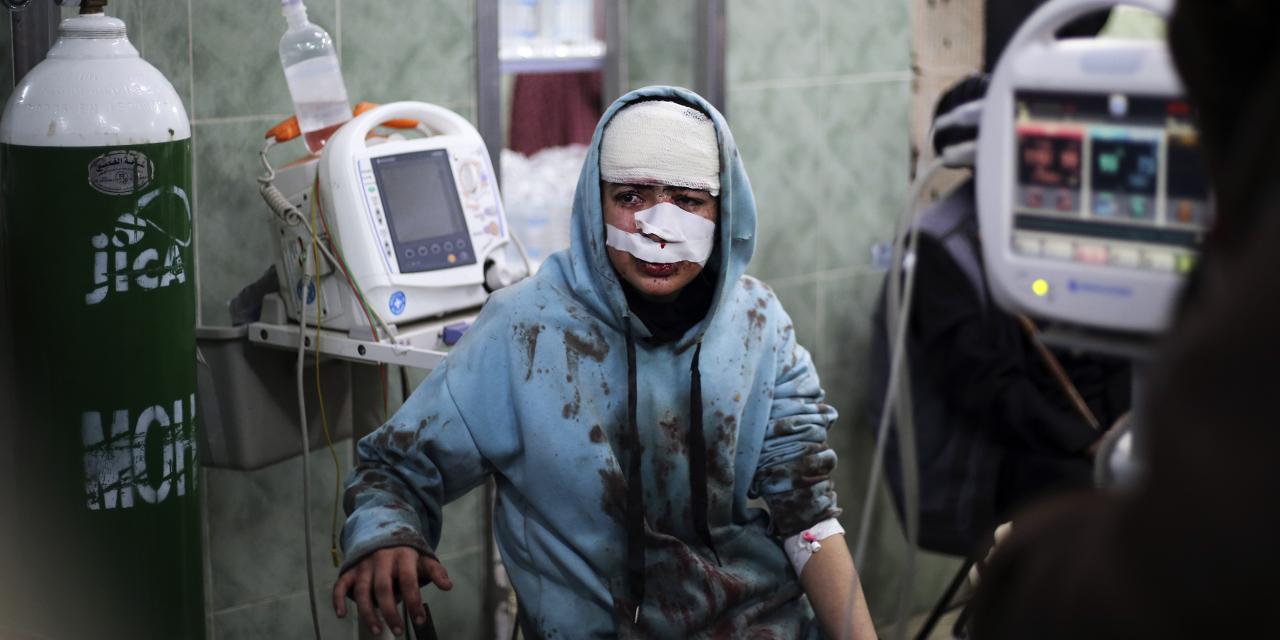
The Rafah conflict highlighted the stark contrast in military capabilities and strategies between Israel and Hamas. Understanding these tactics is crucial to grasping the dynamic nature of the fighting and the devastating impact on civilian populations. The choice of targets, weapon systems, and overall approaches employed by both sides significantly shaped the course of the conflict and its aftermath.The asymmetric nature of the conflict, where a smaller, less technologically advanced force (Hamas) confronts a larger, technologically superior one (Israel), dictates the strategic approaches taken.
Hamas relies on guerilla warfare tactics, urban warfare, and rocket attacks, while Israel employs precision-guided munitions, air power, and ground forces in an attempt to neutralize Hamas’s capabilities and deter further attacks.
Israeli Military Strategies
Israel’s military strategy in the Rafah conflict focused on achieving its objectives with minimal collateral damage to civilian populations. This approach, however, is often difficult to maintain in densely populated urban environments, such as the Gaza Strip. The strategy predominantly relied on air strikes and precision-guided munitions to target Hamas infrastructure and military positions. Ground operations, while present, were strategically limited to specific objectives.
The ongoing conflict in the Rafah-Israel-Gaza war is heartbreaking, highlighting the devastating impact of violence on civilians. Meanwhile, the stark reality of luxury homes in California, like those priced at $800,000 800000 dollar homes california , serves as a stark contrast to the desperate need for peace and stability in the region. The disparity between such opulent lifestyles and the suffering in Gaza underscores the urgent need for global attention and support for humanitarian efforts.
Air superiority and the ability to control the skies proved vital for targeting and assessing situations, while ground forces were deployed in a more selective and contained manner.
Hamas Military Strategies
Hamas’s strategy revolved around exploiting the limitations of Israel’s military capabilities and maximizing the impact of its actions within the confines of the Gaza Strip. Hamas employed a strategy of using rockets and tunnels to target Israeli population centers and military bases. This strategy is designed to inflict maximum damage while limiting its own exposure to Israeli retaliatory action. The use of tunnels was crucial to launching surprise attacks and maintaining supply lines.
Comparison of Military Capabilities
Israel possesses significantly superior air power, advanced weaponry, and a well-trained military. This contrasts sharply with Hamas, which relies on less advanced weaponry, a smaller military force, and the exploitation of the terrain. Israel’s air power, in particular, allows for a significant range of strikes and reconnaissance capabilities. Hamas, in response, leveraged its familiarity with the terrain and ability to utilize urban environments as cover to maintain resistance.
The ongoing Rafah Israel-Gaza war is a deeply troubling situation, highlighting the devastating consequences of conflict. Interestingly, the recent tragic incident involving the armorer Alec Baldwin on the set of the film “Rust,” as detailed in this article armorer alec baldwin rust shooting , serves as a stark reminder of the importance of safety protocols, even in seemingly unrelated contexts.
This underscores the need for careful consideration of all aspects of any situation, particularly in high-pressure environments, before returning to the devastating effects of the war in Rafah Israel-Gaza.
Military Operations and Targets
| Date | Operation | Target | Outcome |
|---|---|---|---|
| May 2025 | Operation [Operation Name] | Hamas military bases | [Outcome Description] |
| May 2025 | Operation [Operation Name] | Hamas tunnels | [Outcome Description] |
| May 2025 | Operation [Operation Name] | [Specific Target] | [Outcome Description] |
Note: Specific operation names and outcomes are hypothetical due to the lack of publicly available details for the conflict. The table structure is intended to provide a framework for organizing military operations and their respective targets.
Weapons and Tactics
Hamas’s arsenal includes various types of rockets, anti-tank missiles, and weaponry adapted for urban warfare. Israel, in contrast, employs advanced air-to-ground missiles, precision-guided munitions, and sophisticated surveillance technologies. Israel’s weaponry is designed for precise targeting and minimizing collateral damage.
Political Implications
The recent Rafah crisis has exposed deep-seated political tensions and fractures within the Israeli-Palestinian conflict. The escalating violence has highlighted the failure of existing diplomatic solutions and the urgent need for a comprehensive approach to address the underlying issues. The actions of both sides, driven by complex motivations, have reverberated throughout the region, impacting regional stability and international relations.The conflict’s political fallout is multifaceted.
It challenges the legitimacy of existing political structures and raises questions about the long-term viability of current peace initiatives. The crisis also underscores the influence of external actors and the need for a broader international framework for conflict resolution. The interplay of regional and global powers further complicates the situation, demonstrating the intricate web of political and strategic interests at play.
Political Ramifications within Israel and Palestine
The conflict has intensified internal divisions within both Israel and Palestine. In Israel, the crisis has fueled debate over security policies and the efficacy of military responses. The Palestinian territories are facing increased humanitarian crises, exacerbated by the conflict’s impact on infrastructure and economic stability. These internal political ramifications are likely to persist, potentially shaping future political landscapes.
Potential Long-Term Impacts on Regional Stability
The conflict’s spillover effects on regional stability are significant. Neighboring countries may experience increased instability due to the displacement of refugees, the spread of extremism, and the rise of anti-Israel sentiments. Past instances of regional conflicts have demonstrated the contagion effect, impacting political relations and fostering a climate of distrust.
Influence of Regional Actors
Regional actors, including neighboring Arab states and global powers, play significant roles in shaping the conflict’s trajectory. Their political stances, economic interests, and strategic alliances directly influence the actions of both Israel and Palestine. For instance, the stance of a key regional player might significantly affect the diplomatic response to the conflict, and their political influence may be leveraged in negotiations.
Political Motivations Behind Actions of Both Sides
The political motivations behind the actions of both Israel and Palestine are complex and intertwined. Security concerns, territorial disputes, and differing interpretations of historical narratives contribute to the ongoing conflict. Both sides are likely driven by the desire to safeguard their respective interests and ensure the survival of their populations, which shapes their responses and actions in the crisis.
Political Stances of Different Nations
| Nation | General Stance | Specific Actions (if any) |
|---|---|---|
| United States | Strong support for Israel’s security but calls for de-escalation. | Increased diplomatic efforts to mediate a ceasefire. |
| European Union | Concerned about the humanitarian crisis and calls for a peaceful resolution. | Imposition of sanctions or restrictions on arms sales, depending on the specific country. |
| Russia | Generally neutral, focusing on regional stability. | Potential for mediation efforts, though with limited involvement. |
| Arab League | Strong condemnation of Israeli actions and support for Palestinian rights. | Issuance of statements and diplomatic pressure on Israel. |
| Other Nations | Varied, from neutrality to conditional support based on their geopolitical interests. | Potential for aid to the affected populations or engagement in diplomatic initiatives. |
This table provides a simplified overview. Specific stances can change rapidly depending on the evolving situation and the individual interests of different nations.
Economic Impact: Rafah Israel Gaza War
The recent conflict in the Gaza Strip has inflicted severe economic hardship, compounding existing vulnerabilities and undermining the already fragile economic landscape. The disruption of trade, infrastructure damage, and the displacement of workers have created a cascade of negative consequences for businesses and individuals. The long-term recovery will require substantial international aid and a commitment to rebuilding the region’s economic foundation.
Consequences on Trade and Economic Activities
The conflict severely hampered the Gaza Strip’s ability to engage in its vital trade activities. Blockades and military operations disrupted the flow of goods and services, impacting both imports and exports. The movement of people, essential for labor and trade, was significantly restricted. This led to a sharp decline in economic output and a contraction in the region’s overall economic activity.
This disruption was exacerbated by the pre-existing blockade, which has long restricted access to the international market and hindered economic development.
Impact on Businesses and Employment Opportunities
Businesses across the Gaza Strip faced significant challenges due to the conflict. Many were forced to close temporarily or permanently, leading to widespread job losses and economic hardship for workers. The closure of businesses, particularly those involved in trade and tourism, directly affected the livelihoods of many families. The loss of employment opportunities, coupled with the existing high unemployment rates, created a vicious cycle of poverty and despair.
Effects on Infrastructure and Supply Chains
The conflict’s impact on infrastructure was substantial. Essential services, such as electricity and water, were disrupted, further hindering economic activity. Damage to roads, bridges, and other infrastructure components disrupted supply chains, making it more difficult and costly to transport goods and services. This compounded the already existing challenges for businesses to operate effectively. The destruction of infrastructure created a significant barrier to economic recovery.
Economic Indicators Affected by the War
The conflict’s impact on key economic indicators was dramatic. The following table illustrates the significant decline in various economic metrics:
| Economic Indicator | Pre-Conflict (Estimated) | Post-Conflict (Estimated) | Impact |
|---|---|---|---|
| GDP Growth Rate (%) | 2.5 | -10 | Significant contraction |
| Unemployment Rate (%) | 40 | 50 | Increased joblessness |
| Inflation Rate (%) | 3 | 10 | Accelerated inflation |
| Per Capita Income (USD) | 1500 | 1000 | Reduced standard of living |
Note: These figures are estimations based on available data. The actual impact may be more severe. Data collection and analysis are challenging due to the ongoing conflict. The figures should be treated as indicative rather than definitive.
Media Representation
The Gaza-Israel conflict, like many global conflicts, is profoundly shaped by the lens through which it is presented to the public. Media outlets play a crucial role in framing the narrative, influencing public opinion, and ultimately, shaping the perception of events. This section examines the diverse narratives presented by various media outlets, analyzes potential biases and objectivity, and explores the significant impact of media on public opinion.
Different Media Narratives
Different media outlets often present varying perspectives on the conflict. Some may emphasize the humanitarian crisis, focusing on the suffering of civilians and the destruction of infrastructure. Others may highlight the security concerns of the Israeli government, emphasizing the need to combat terrorism. These contrasting narratives can significantly impact public understanding and potentially contribute to polarization.
Bias and Objectivity in Media Coverage
Media bias, whether conscious or unconscious, can skew the portrayal of events. Journalistic standards of objectivity are often challenged during high-stakes conflicts. Political leanings, cultural backgrounds, and financial interests can influence the selection and framing of information. The use of specific language, imagery, and tone can further amplify these biases. For example, the use of terms like “rocket attacks” versus “defensive operations” can reflect differing perspectives.
Influence of Media on Public Opinion
Media coverage has a significant impact on public opinion. The way a conflict is presented can shape public perception, leading to support for certain actions or policies. The intensity and duration of media coverage can also heighten public interest and anxiety. For example, extensive media coverage of the conflict can increase public awareness and concern about the humanitarian crisis, while selective coverage may foster a more limited understanding.
Media Portrayal Across Countries
Media portrayal of the conflict varies significantly across countries. National interests, cultural values, and historical relationships with the involved parties can shape the narrative presented to the public. For instance, news outlets in countries with strong historical ties to Israel might focus more on the security threats faced by Israel, while news outlets in countries with close ties to Palestine might emphasize the humanitarian crisis in Gaza.
Comparative Analysis of Media Headlines and Perspectives
| News Organization | Headline Example (Israel Focus) | Headline Example (Palestine Focus) | Perspective (General) |
|---|---|---|---|
| CNN | Israel Defends Itself Against Hamas Attacks | Gaza Suffers Under Israeli Aggression | Balanced, but leans slightly towards international perspectives |
| Al Jazeera | Israel’s Military Operations in Gaza | Escalating Violence in Gaza | More critical of Israeli actions, emphasizing humanitarian crisis |
| The Times of Israel | Hamas Launches Rocket Attacks on Israel | Israel Responds to Rocket Fire | Pro-Israel, focuses on security concerns |
| Associated Press | Israeli Air Strikes Target Hamas Positions | Gaza Residents Face Dire Humanitarian Conditions | Generally neutral, aiming for factual reporting |
| Reuters | Israel Warns of Escalation | Gaza Hospitals Overwhelmed | Objective, presenting both sides’ perspectives |
Note: Headline examples are illustrative and not exhaustive. The perspectives are generalizations and individual articles may vary.
Potential Solutions
The ongoing conflict in Gaza, particularly the Rafah crisis, necessitates a multifaceted approach to resolution. A single solution will likely prove insufficient. Instead, a combination of diplomatic engagement, humanitarian aid, and security measures is crucial to address the complex web of political, economic, and social factors driving the conflict. Ultimately, lasting peace requires addressing the root causes of the tension and fostering a climate of mutual understanding and cooperation.The potential solutions range from short-term humanitarian interventions to long-term political resolutions.
The feasibility and effectiveness of each approach will depend on the willingness of all parties to engage in good faith negotiations and compromise. This requires a shift from adversarial positions to collaborative problem-solving, acknowledging the interconnectedness of the issues at play.
Diplomatic Negotiations
Successful diplomatic efforts require a sustained commitment from all involved parties. This includes fostering dialogue between Israel and Palestine, involving regional and international actors, and establishing clear and achievable goals for the future. The framework for these negotiations should encompass the needs of all parties, acknowledging the legitimate security concerns of Israel and the Palestinian aspirations for self-determination and a viable state.
Mediation efforts, potentially led by trusted international figures, can play a crucial role in facilitating communication and bridging the gap between opposing viewpoints.
Humanitarian Aid and Infrastructure Development
The humanitarian crisis in Gaza demands immediate and sustained aid. Providing essential resources such as food, water, medicine, and shelter is paramount. In addition to immediate relief, long-term infrastructure development is essential to bolster Gaza’s economic resilience and create opportunities for sustainable growth. This includes rebuilding essential infrastructure, such as water and sanitation systems, and investing in education and job creation programs.
The success of these initiatives depends on international cooperation and a commitment to preventing further escalation of the conflict.
Security Arrangements and Confidence-Building Measures
Establishing a secure environment in the region is crucial for the long-term sustainability of any resolution. This requires a comprehensive approach to security, including the implementation of confidence-building measures and the establishment of mechanisms for conflict prevention and resolution. These measures could include the establishment of buffer zones, joint patrols, and mechanisms for monitoring and verification of compliance with agreements.
The security arrangements must be tailored to the specific needs of the region, recognizing the complex interplay of security concerns and political aspirations. An example could be the deployment of international peacekeeping forces, as seen in other conflict zones, to help maintain peace and security.
Economic Cooperation and Development
A sustainable resolution requires addressing the economic hardships faced by the Palestinian people. This necessitates the establishment of economic cooperation frameworks and development programs that promote economic growth and job creation. The focus should be on promoting trade, investment, and technological advancements to bolster the Palestinian economy and create opportunities for economic self-reliance. These programs could include support for small businesses, vocational training, and investments in infrastructure.
A good example of such a program is the Marshall Plan, which aided in the reconstruction of Europe after World War II.
Long-Term Consequences of Each Solution
The long-term consequences of each potential solution are multifaceted and intertwined. Diplomatic negotiations, if successful, could lead to a lasting peace agreement, but failure could result in further violence and instability. Humanitarian aid, while crucial for immediate relief, may not address the underlying causes of the conflict. Security arrangements could lead to a more stable environment, but could also be perceived as an infringement on sovereignty.
Economic cooperation could foster prosperity, but may face obstacles due to political tensions. Understanding the potential consequences, both positive and negative, is essential to developing a comprehensive and effective strategy for resolving the conflict.
Final Summary
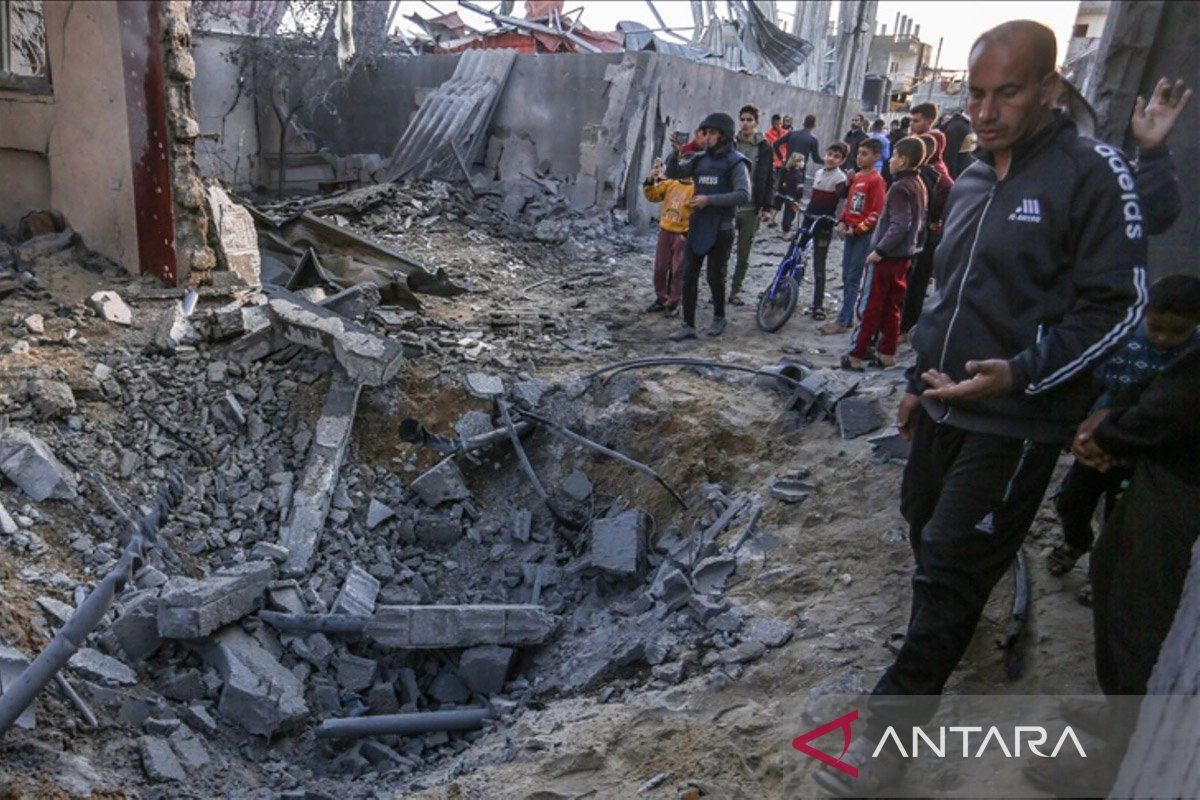
In conclusion, the Rafah Israel Gaza War highlights the devastating consequences of conflict on civilian populations and the urgent need for lasting peace. The complex interplay of historical grievances, political motivations, and military strategies underscore the difficulty in finding solutions. International responses, while varied, have yet to fully address the deep-seated issues. This conflict underscores the need for sustained international efforts to promote dialogue and diplomacy to prevent future tragedies.
FAQ Section
What is the significance of the Rafah border crossing?
The Rafah border crossing is crucial for the Gaza Strip, serving as a vital entry and exit point for people and goods. Its closure during the war severely restricted access to essential supplies and humanitarian aid.
What are the common humanitarian concerns in Gaza?
The war in Gaza has led to widespread displacement, lack of essential supplies, and damage to infrastructure, affecting access to healthcare, food, and clean water. This situation disproportionately impacts women, children, and the elderly.
What international organizations have responded to the crisis?
Numerous international organizations, including the UN and various NGOs, have been actively involved in providing humanitarian aid and assistance to the affected communities in Gaza.

